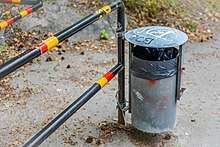Waste container

A waste container is a container for temporarily storing waste, and is usually made out of metal or plastic. Some common terms are dustbin, garbage can, and trash can. The words "rubbish", "basket" and "bin" are more common in British English usage; "trash" and "can" are more common in American English usage. "Garbage" may refer to food waste specifically (when distinguished from "trash") or to municipal solid waste in general. In 1875, the first household rubbish bins were introduced in Britain to create a regulated system of collection.
Public waste collection
In many cities and towns, there is a public waste collection service which regularly collects household waste from outside buildings etc. This will be loaded into a garbage truck and driven to a landfill, incinerator or crush facility to be disposed of. Household waste containers are usually either:
- trash cans, receptacles made of metal or plastic
- wheelie bins, light, mobile plastic bins[1]
In some areas, each household has multiple bins for different categories of rubbish (usually represented by colours) depending on its suitability for recycling.[2]
Commercial roadside waste containers are often larger dumpsters or skips.
Public litter bins

Public areas, such as parks, often have litter bins placed to improve the social environment by encouraging people not to litter. Such bins in outdoor locations or other busy public areas are usually mounted to the ground or wall to discourage theft, and reduce vandalism, and to improve their appearance are sometimes deliberately artistic or cute. In dense urban areas, trash is stored underground below the receptacle.[3] Some trash cans have plastic bags to help contain liquids.
Metaphors

The term "garbage can" is also used for a model of decision making, the "Garbage Can Model" of decision making. It is concerned with cases of decision making in great aggregate uncertainty which can cause decisions to arise that from a distant point of view might seem irrational.
A "trash can" metaphor is often used in computer operating system desktop environments as a place files can be moved for deletion.
In a workplace setting, a bin may be euphemistically called "the circular file" or "the round file". Whereas useful documents are filed in a filing cabinet, which is rectangular, junk mail and other worthless items are "filed" in the bin, which is often round.
See also
References
- ↑ Smyth, Sara (15 January 2014). "Councils to reduce size of wheelie bins by almost half for 6 million households in bid to cut expenses and meet recycling targets". Mail Online Daily Mail. Associated Newspapers. Archived from the original on 22 September 2015. Retrieved 16 August 2015.
- ↑ "Rubbish and recycling" Archived 2016-06-12 at the Wayback Machine., ccc.govt.nz
- ↑ Shendruk, Amanada (5 August 2018). "Could NYC solve its trash problem with underground trash cans?". Quartz (publication). Retrieved 5 September 2018.
- American Public Transportation Association (2008-09-26). "Recommended Practice for Trash/Recycling Container Placement to Mitigate the Effects of an Explosive Event" (PDF). Retrieved 2014-09-15.
External links
